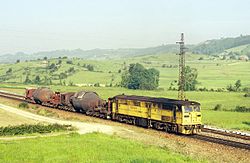Aceralia
Aceralia was a large Spanish steel producer formed in 1997 by restructuring of a group formed from earlier mergers of the steel producers ENSIDESA and Altos Hornos de Vizcaya. The company merged into Arcelor in 2001, and became part of ArcelorMittal in 2006.
History

In 1950 the state owned company Empresa Nacional Siderúrgica Sociedad Anónima (ENSIDESA) was formed in Avilés over a 11km by 0.5km campus with 14,000 employees,[2][3] to increase Spain's steel production,[4] part of the industrialisation and modernisation of Spain. This led to the Spanish economic miracle of the 1960s.[5] In 1973 the state owned company was forced to take over the Asturian steel company UNINSA, which owned works in Veriña,[2] and which had invested heavily in a fully integrated steel works but did not have the capital to fund it.[6] At some point in the 1970s, ENSIDESA employed as many as 27,000 workers.[7]



In 1991 the state owned company ENSIDESA was merged with Altos Hornos de Vizcaya to form the Corporacion de la Siderurgia Integral from which the Corporación Siderúrgica Integral (CSI) was formed in 1994 from the more profitable parts (as part of a privatisation process).[4]
In 1997 Aceralia Corporación Siderúrgica was formed by reorganisation of CSI, the same year the company formed a strategic alliance with the Luxembourg-based steel group Arbed.[4] As soon as it was formed, it was also privatised.[8] The group also acquired the Aristrain Group (steel sections), and Ucín (rebar, wire rod), in the process becoming the largest steel company in Spain.[4]
In 2001 the company merged with two other European steel producers, ARBED and Usinor, to form Arcelor.[9]
It became part of ArcelorMittal in 2006 with a plant in Avilés and Gijón, Etxebarri, Lesaka and Legasa, Sagunto and Sestao (part of Greater Bilbao), and is now known as ArcelorMittal Asturias.[citation needed]
As of 2010, the Veriña furnaces were supplied with coke from a plant in Avilés, whose eight production lines could then furnish 1.4 million tonnes per annum by train and by truck, one of which can carry 23,000 kilos.[10]
In October 2020 the number of employees in the Asturian operation dropped below 5,000.[7]
On 30 September 2022, management shut down one of two furnaces at the Veriña plant. The two were, at the time, the only two steel furnaces in the whole of Spain.[11]
See also
References
- ^ a b c d "1997 Annual Report" (PDF). Aceralia. Retrieved 2020-12-01.
- ^ a b "Web Municipal del Ayuntamiento de Gijón".
- ^ "La Siderúrgica de Avilés (Ensidesa)". July 2016.
- ^ a b c d "History of Aceralia". www.arcelormittal.com. ArcelorMittal. Archived from the original on 2010-09-24.
- ^ "ENSIDESA. LA CONSTRUCCIÓN DE UNA GRAN SIDERURGIA EN LA DICTADURA DEL GENERAL FRANCO" Jorge Bogaerts Spagna contemporanea, 2000, n. 17, pp. 119-138
- ^ Pierangelo Maria Toninelli, p.222
- ^ a b "Arcelor baja de los 5.000 empleos en Asturias". 11 October 2020.
- ^ Pierangelo Maria Toninelli, pp.218 & 222
- ^ "History of Arcelor". www.arcelormittal.com. ArcelorMittal. Archived from the original on 2010-09-24.
- ^ "El alimento de los hornos altos". 30 August 2010.
- ^ "ArcelorMittal para un tercio de sus hornos altos en la Unión Europea". 30 September 2022.
Sources
- Pierangelo Maria Toninelli (2000). The rise and fall of state-owned enterprise in the western world. Cambridge University Press. Public versus private growth patterns: Case studies : The Iron and Steel Industry, pp.220-222. ISBN 9780521780810.